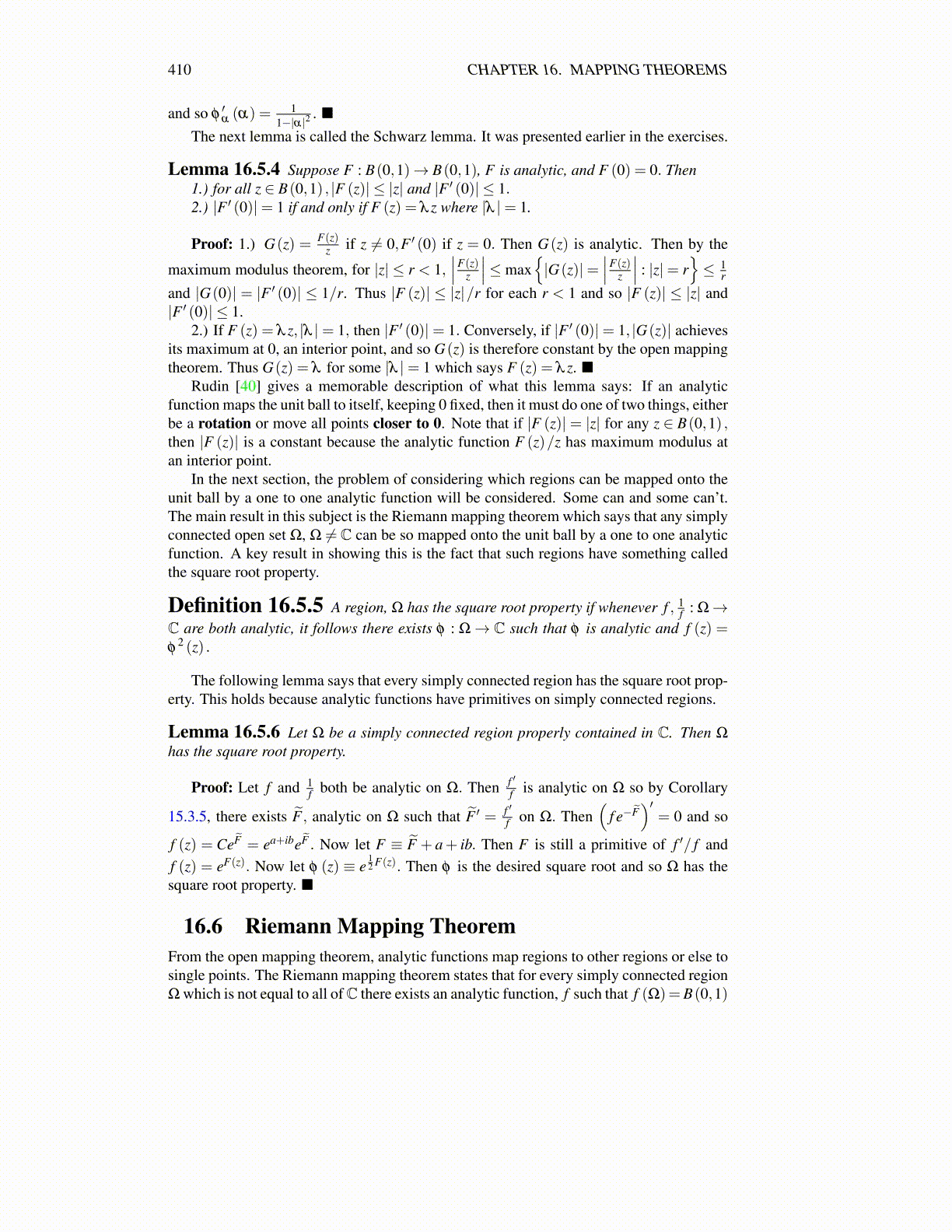
410 CHAPTER 16. MAPPING THEOREMS
and so φ′α (α) = 1
1−|α|2. ■
The next lemma is called the Schwarz lemma. It was presented earlier in the exercises.
Lemma 16.5.4 Suppose F : B(0,1)→ B(0,1), F is analytic, and F (0) = 0. Then1.) for all z ∈ B(0,1) , |F (z)| ≤ |z| and |F ′ (0)| ≤ 1.2.) |F ′ (0)|= 1 if and only if F (z) = λ z where |λ |= 1.
Proof: 1.) G(z) = F(z)z if z ̸= 0,F ′ (0) if z = 0. Then G(z) is analytic. Then by the
maximum modulus theorem, for |z| ≤ r < 1,∣∣∣F(z)
z
∣∣∣ ≤ max{|G(z)|=
∣∣∣F(z)z
∣∣∣ : |z|= r}≤ 1
r
and |G(0)| = |F ′ (0)| ≤ 1/r. Thus |F (z)| ≤ |z|/r for each r < 1 and so |F (z)| ≤ |z| and|F ′ (0)| ≤ 1.
2.) If F (z) = λ z, |λ |= 1, then |F ′ (0)|= 1. Conversely, if |F ′ (0)|= 1, |G(z)| achievesits maximum at 0, an interior point, and so G(z) is therefore constant by the open mappingtheorem. Thus G(z) = λ for some |λ |= 1 which says F (z) = λ z. ■
Rudin [40] gives a memorable description of what this lemma says: If an analyticfunction maps the unit ball to itself, keeping 0 fixed, then it must do one of two things, eitherbe a rotation or move all points closer to 0. Note that if |F (z)| = |z| for any z ∈ B(0,1) ,then |F (z)| is a constant because the analytic function F (z)/z has maximum modulus atan interior point.
In the next section, the problem of considering which regions can be mapped onto theunit ball by a one to one analytic function will be considered. Some can and some can’t.The main result in this subject is the Riemann mapping theorem which says that any simplyconnected open set Ω, Ω ̸= C can be so mapped onto the unit ball by a one to one analyticfunction. A key result in showing this is the fact that such regions have something calledthe square root property.
Definition 16.5.5 A region, Ω has the square root property if whenever f , 1f : Ω→
C are both analytic, it follows there exists φ : Ω→ C such that φ is analytic and f (z) =φ
2 (z) .
The following lemma says that every simply connected region has the square root prop-erty. This holds because analytic functions have primitives on simply connected regions.
Lemma 16.5.6 Let Ω be a simply connected region properly contained in C. Then Ω
has the square root property.
Proof: Let f and 1f both be analytic on Ω. Then f ′
f is analytic on Ω so by Corollary
15.3.5, there exists F̃ , analytic on Ω such that F̃ ′ = f ′f on Ω. Then
(f e−F̃
)′= 0 and so
f (z) = CeF̃ = ea+ibeF̃ . Now let F ≡ F̃ + a+ ib. Then F is still a primitive of f ′/ f andf (z) = eF(z). Now let φ (z) ≡ e
12 F(z). Then φ is the desired square root and so Ω has the
square root property. ■
16.6 Riemann Mapping TheoremFrom the open mapping theorem, analytic functions map regions to other regions or else tosingle points. The Riemann mapping theorem states that for every simply connected regionΩ which is not equal to all ofC there exists an analytic function, f such that f (Ω)=B(0,1)